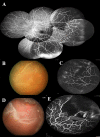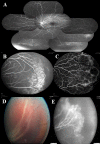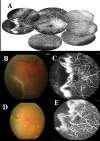Peripheral Retinal Vascular Patterns in Patients with Rhegmatogenous Retinal Detachment in Taiwan
- PMID: 26909812
- PMCID: PMC4766194
- DOI: 10.1371/journal.pone.0149176
Peripheral Retinal Vascular Patterns in Patients with Rhegmatogenous Retinal Detachment in Taiwan
Abstract
This is an observational study of fluorescein angiography (FA) in consecutive patients with rhegmatogenous retinal detachment (RRD) in Changhua Christian Hospital to investigate the peripheral retinal vascular patterns in those patients. All patients had their age, sex, axial length (AXL), and refraction status (RF) recorded. According to the findings in FA of the peripheral retina, the eyes were divided into 4 groups: in group 1, there was a ramified pattern of peripheral retinal vasculature with gradual tapering; in group 2, there was an abrupt ending of peripheral vasculature with peripheral non-perfusion; in group 3, there was a curving route of peripheral vasculature forming vascular arcades or anastomosis; and in group 4, the same as in group 3, but with one or more wedge-shaped avascular notches. Comparisons of age, sex, AXL, and RF, association of breaks with lattice degeneration and retinal non-perfusion, surgical procedures utilized, and mean numbers of operations were made among the four groups. Of the 73 eyes studied, there were 13 eyes (17.8%) in group 1, 3 eyes (4.1%) in group 2, 40 eyes (54.8%) in group 3 and 17 eyes (23.3%) in group 4. Significant differences in age, AXL and RF, and association of retinal breaks to non-perfusion were noted among the four groups. Patients in group 1 had older ages, while younger ages were noted in groups 3 and 4. Eyes in group 1 had the shortest average AXL and were least myopic in contrast to the eyes in groups 3 and 4. Association of retinal breaks and retinal non-perfusion was significantly higher in groups 2, 3 and 4 than in group 1. In conclusion, peripheral vascular anomalies are common in cases with RRD. Patients with peripheral non-perfusion tend to be younger, with longer axial length and have the breaks associated with retinal non-perfusion.
Conflict of interest statement
Figures




Similar articles
-
[Optical coherence tomography: anatomic and functional outcome after scleral buckling surgery in macula-off rhegmatogenous retinal detachment].Klin Monbl Augenheilkd. 2013 Aug;230(8):814-9. doi: 10.1055/s-0032-1328422. Epub 2013 May 13. Klin Monbl Augenheilkd. 2013. PMID: 23670523 German.
-
Anatomical and functional results of primary pars plana vitrectomy in rhegmatogenous retinal detachment.Klin Monbl Augenheilkd. 2013 Apr;230(4):409-12. doi: 10.1055/s-0032-1328392. Epub 2013 Apr 29. Klin Monbl Augenheilkd. 2013. PMID: 23629793
-
Retinal breaks and rhegmatogenous retinal detachment in association with branch retinal vein occlusion.Ophthalmic Surg Lasers. 1999 Apr;30(4):285-8. Ophthalmic Surg Lasers. 1999. PMID: 10219032
-
Clinical characteristics and surgical management of familial exudative vitreoretinopathy-associated rhegmatogenous retinal detachment.Retina. 2012 Feb;32(2):220-5. doi: 10.1097/IAE.0b013e31821c3ec5. Retina. 2012. PMID: 22277905
-
[A new approach for studying the retinal and choroidal circulation].Nippon Ganka Gakkai Zasshi. 2004 Dec;108(12):836-61; discussion 862. Nippon Ganka Gakkai Zasshi. 2004. PMID: 15656089 Review. Japanese.
Cited by
-
Nonperfused Peripheral Retinal Area in Eyes with Chronic Rhegmatogenous Retinal Detachment.Case Rep Ophthalmol. 2020 Jul 28;11(2):385-390. doi: 10.1159/000509157. eCollection 2020 May-Aug. Case Rep Ophthalmol. 2020. PMID: 32884554 Free PMC article.
-
Quantitative Analysis of Retinal Vasculature in Rhegmatogenous Retinal Detachment Based on Ultra-Widefield Fundus Imaging.Front Med (Lausanne). 2022 Jan 18;8:797479. doi: 10.3389/fmed.2021.797479. eCollection 2021. Front Med (Lausanne). 2022. PMID: 35118092 Free PMC article.
-
Evaluation of rhegmatogenous retinal detachments using Optos ultrawide field fundus fluorescein angiography and comparison with ETDRS 7 field overlay.J Curr Ophthalmol. 2018 Jul 3;30(3):263-267. doi: 10.1016/j.joco.2018.06.006. eCollection 2018 Sep. J Curr Ophthalmol. 2018. PMID: 30197958 Free PMC article.
References
-
- Rowe JA, Erie JC, Baratz KH, Hodge DO, Gray DT, Butterfield L, et al. Retinal detachment in Olmsted County, Minnesota, 1976 through 1995. Ophthalmology 1999;106:154–9. - PubMed
-
- Wong TY, Tielsch JM, Schein OD. Racial difference in the incidence of retinal detachment in Singapore. Arch Ophthalmol 1999;117:379–83. - PubMed
-
- Li X, Beijing Rhegmatogenous Retinal Detachment Study Group. Incidence and epidemiological characteristics of rhegmatogenous retinal detachment in Beijing, China. Ophthalmology 2003;110:2413–7. - PubMed
Publication types
MeSH terms
Supplementary concepts
LinkOut - more resources
Full Text Sources
Other Literature Sources
Medical
Research Materials
Miscellaneous

